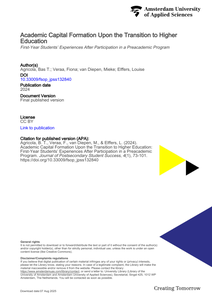The transition from secondary education to the first year of higher education is a phase in which students are faced with many challenges. First-year students may lack the academic capital that is needed to understand explicit and implicit rules of higher education. We investigated students’ participation in a preacademic program and the development of their academic capital. In a mixed method study, we showed that first-year students who participated in a preacademic program perceived peer mentors and teachers to be relevant sources of information, learned how to overcome educational barriers, and became more acquainted with explicit and implicit college requirements.
LINK
These are hard days for companies: they have to survive in a market that has been hit by a financial crisis. Many countries in Europe have severe problems trying to overcome this financial crisis. The main remedy applied by governments is to cut back on expenditure, but on the other hand it is said that it is important for a country, and especially for companies, to invest in innovation. These innovations should lead to innovative products that will lead to profitability turnovers for these companies and, as a consequence, improve the economic conditions in a country. Universities provide students with engineering competences, like develop innovation, with which they can show a higher degree of ability to answer complex questions such as how to become players in the market again. Teaching students to become more innovative engineers, Fontys University of Applied Sciences, Department of Engineering, has designed a curriculum in which students are educated in the competence innovation. An important element in the process of teaching innovation to students is the approach of inquiring into possibilities of patents. In the second semester of the first year, students can decide to join an innovative project called: ‘The invention project’. The basis of this project is that students are given the opportunity to create their own invention and with their previously acquired knowledge and skills they design, calculate, prototype and present their invention. In a research project, the experiences of students in this Invention Project have been analysed. The goal of this study was to understand what the success factors are for such a project. The basis of this inquiry is a questionnaire to identify the opinions of students. The research was carried out in the spring semester of 2012. In total 31 students were involved in this research. The results show that there was a high degree of student satisfaction about the Invention Project focused on innovation development. Success factors for this project in the first year of the curriculum were seen: 1 to work on own inventions, 2 development of student’s perception of the total product creation process and 3 to make students see the relevance of contacts with real professionals from industry and from the patent office in their own project. Improvements can be made by: 1 helping students more during the creativity stage in the project and 2 to coach them more on the aspect of engineering a successful invention of which they can be proud. This Invention project is a interesting with which collaborations with other universities can be set up.
DOCUMENT

The transition from secondary education to the first year of higher education is a phase in which students are faced with many challenges. First-year students may lack the academic capital that is needed to understand explicit and implicit rules of higher education. We investigated students’ participation in a preacademic program and the development of their academic capital. In a mixed method study, we showed that first-year students who participated in a preacademic program perceived peer mentors and teachers to be relevant sources of information, learned how to overcome educational barriers, and became more acquainted with explicit and implicit college requirements.
DOCUMENT
